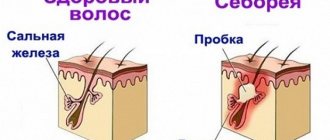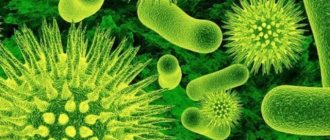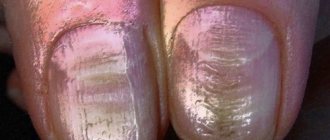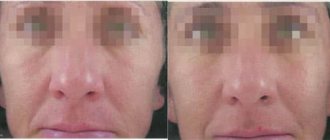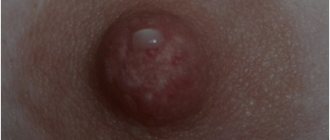Main reasons for development
Ring-shaped erythema is always a sign of some kind of problem in the body. Changes in the condition of the skin can be caused by:
- infection with borreliosis after a tick bite,
- rheumatic diseases, also accompanied by damage to joint tissue,
- tuberculosis and other infectious diseases,
- growth of a malignant tumor,
- intoxication,
- allergic reaction to medications or other irritants,
- changes in hormonal levels due to endocrine diseases or during pregnancy.
Sometimes doctors cannot explain what exactly caused the appearance of red rings on the skin.
Symptoms
Occurring at any age, these lesions appear as raised pink-red rings or rings. Their size varies from 0.5 to 8 cm (0.20–3.15 in). The lesions sometimes increase in size and spread over time and may not be complete but irregular in shape. The spread usually occurs on the thighs and legs, but may also appear on the upper extremities, areas not exposed to sunlight, the torso, or the face. EAC is not currently known to be contagious, but since many cases of EAC are misdiagnosed, it is difficult to be sure.
Diagnostic and treatment methods
The primary diagnosis of ring-shaped erythema of the skin is carried out by dermatologists. The doctor will examine the affected areas of the skin and collect anamnesis, after which he will develop an examination program. This may include:
- taking scrapings or smears from the surface of the rings with subsequent laboratory testing - allows you to exclude fungal infections,
- blood tests will help identify hidden inflammatory processes,
- assessment of hormonal levels - if endocrine diseases are suspected,
- tests for allergies to medications, household chemicals, food - a panel of allergens is selected taking into account the patient’s medical history and complaints,
- research to rule out parasite infection.
Based on the results of the initial diagnosis, the dermatologist can develop a therapy program or refer the patient to another specialist. The treatment method depends on the cause of the pathology:
- for bacterial infections, antibiotics and anti-inflammatory drugs are prescribed,
- allergies require taking antihistamines and avoiding contact with the allergen.
For all patients, the doctor can additionally prescribe local remedies that will help relieve swelling and get rid of rashes, forget about pain and itching, and speed up the restoration of the epidermis.
All articles
5% discount Print coupon from our website
Ask your question on the website Get professional advice!
How to make an appointment with an allergist
You can make an appointment with a specialist from JSC “Medicine” (clinic of Academician Roitberg) on the website through a special feedback form. You can also call +7. We are located in the Central Administrative District, at the address: 2nd Tverskoy-Yamskoy lane 10. The metro station is located nearby. Mayakovskaya, metro station Belorusskaya, metro station Novoslobodskaya, Tverskaya metro station, Chekhovskaya metro station.
An allergist will perform a visual examination, take into account the severe symptoms and conduct a number of research activities. Based on the data obtained, a diagnosis will be made and treatment will be prescribed. After completion of therapy, a repeat study will be performed.
Archives
Short Wiklad
Sylvia Hsu, Elaine H. Le, Mohamad R. Khoshevis Am Fam Physician 2001;64:289-96
Ring-like lesions of the skin appear frequently and occur quickly, sometimes making them difficult to diagnose. The smell appears as ring-shaped or oval macules or spots with an erythematous peripheral part and clear spots at the center. Their most common etiology in the adult population is dermatophytosis, which can be successfully diagnosed without a biopsy. Other illnesses may manifest themselves in the same way (Table 1). The doctor tries to turn off other illnesses, especially if anterior treatment for dermatophytosis was unsuccessful.
Table 1. Diseases that manifest themselves as ring-like lesions on the skin
| Diagnosis | Clinic | Likuvannya |
| Dermatophytosis tuba | Ring-like, erythematous plaques or papules on the skin without hair, covered with patches | Local and systemic stagnation of antifungal drugs |
| Ringworm | Small oval patches of a yellowish-brown color with small patches along the edges of the Langer lines on the skin | Local or systemic stasis of corticosteroids; UVA, UVB |
| Ring-like granuloma | Thick ring-shaped plaques and papules in the color of the skin without peeling, especially located on the ends | Local stasis of corticosteroids or their administration at the site of depression |
| Sarcoidosis | Severe, erythematous plaques | Local and systemic stasis of corticosteroids or their administration at the site of depression; antimalarial drugs; thalidomide |
| Leprosy | Erythematous annular plaques, with or without crusty skin | Dapsone; rifampicin |
| Kropyvnytsia | Ring-like erythematous plaques without scaling of the skin, which appear for a short hour | Oral antihistamines |
| Pre-hide red shepherd | Ring-like or psoriasiform plaques, with or without crusted skin, on areas of the body where sleepy tissues fall | Local and systemic stasis of corticosteroids or their administration at the site of depression; antimalarial drugs |
| Circular subcentral erythema | Ring-like patches with erythematous edges and vein-like lesions at the center | Local or systemic stasis of corticosteroids; oral antihistamines; feast of the primary illness |
Notes. UVA - ultraviolet light type A (wavelength 320–400 nm), UVB - ultraviolet light type B (wavelength 290–320 nm).
DERMATOPHYTIA TULUBA
Dermatophytosis tuba is a superficial fungal infection of the skin (with localization on the hands, feet, scalp, face and crotch). The most frequent events lie before the birth of Trichophyton, Microsporum
ta
Epidermophyton
.
In the USA, Trichophyton rubrum, Trichophyton tonsurans, Trichophyton mentagrophytes
and
Microsporum canis
. All dermatophytes have aerobes and are capable of acquiring keratin, which can therefore penetrate the corneal skin.
| The most common cause of ring-like skin lesions in adults is dermatophytosis |
People become infected with pathogens of dermatophytosis through close contact with infected individuals, creatures or the earth. Sometimes self-infection occurs through infected nails, scalp or feet. The risk of illness should be avoided in the post-pubertal age, although patients from the pre-teen age should be treated. Representatives of both articles fall ill with the same frequency. The main factors of the risk are the peculiarities of the climate and the environment of people. Fungal infections are caused by warm environmental conditions (huge showers, swimming pools) and the use of other people's towels, clothes and toilet items. Trival depletion of systemic corticosteroids promotes the risk of such fungal infections.
Patients have clearly demarcated, erythematous plaques or papules on the skin, which can progressively increase in size over time. At their edges there is an active process of fermentation; they may be slightly raised or covered with wedges (Fig. 1).
Rice. 1.
Clearly demarcated, erythematous plaques with raised edges, covered with flakes, with dermatophytosis of the tubes.
Fastening for additional care KOH
To establish a diagnosis, it is necessary to microscopically detect the fungus in a preparation doped with KOH. Using a scalpel, lightly (so as not to cause bleeding or pain) pluck the small pieces from the active edge of the element. They are transferred to a slide and covered with a curved slide. Add 10–15% drops of KOH with dimexide or without it. Afterwards, carefully heat the mixture (preparations with dimexide do not require heating). Superheated or boiled liquid will lead to crystallization of KOH, creating crazy artifacts.
The eye is quilted at low magnification of the microscope. Under the action of KOH, the heated cellular membrane of keratinocytes breaks down, so that long-term, direct or fragile hyphys of the fungus can be easily damaged. These structures can also become loose, but have a different diameter. If repeated treatment for additional KOH causes negative results, and the patient is clinically suspected of having a dermatophytic infection, it is necessary to take a culture (the result can be seen after 2–4 days).
Treatment of dermatophytosis tuba
If you want to treat dermatophytosis tubules with the help of numerous local and systemic antifungal drugs, it is quite simple, without the risk of re-infection. After treatment there is no contact with infected people, creatures or the earth. In case of localized infections, it is better to try local treatment with topical imidazoles (clotrimazole and miconazole) or allylamines (naftifine, terbunafine and butenafine).
Systemic antifungal drugs (griseofulvin, terbinafine or itraconazole) are indicated for lichen annularis, resistant to local treatment, or with its intolerance; an important interruption or a massive storm; chronic infection; primary or secondary immunodeficiency; affected by dermatophytosis of the skin with hyperkeratosis (the loins and feet). Although ketoconazole is also effective, it is characterized by potentially dangerous side effects: weakening of the liver and suppression of sterol metabolism. The severity of the initial course of oral therapy becomes 2 years old. Unfortunately, systemic antifungal drugs are expensive and may interact with other drugs.
Ringworm
Lichen erysipelas is a widened, self-circumscribed, psoriasimorphic viscus, which may indicate dermatophytosis of the tuberculosis. Although its etiology is not entirely clear, current data indicate that it may be a viral exanthema. Tinea erysipelas often occurs in sick people from 20 to 40 years of age, while sickness is avoided in young and mature adults. Women get sick more often; spring and summer seasonality is typical.
If you want more elements of visipa in patients with lichen erysipelas, represented by macules, papules and plaques, the primary cavity (“maternal plaque”), you can have the appearance of a ring-like skin with hyperemia, some raised edges, dribbling They have little strips and light spots at the center (Fig. 2). The primary cavity is primarily represented by one oval-shaped macula on a tube with a diameter of 2–10 cm. Although the majority of patients who suffer from viscera are asymptomatic, in 5% of patients it appears before the appearance of the primary cavity. headache, weakness, arthalgia, groves, vomiting , diarrhea and nervousness. Over the course of 7–14 days, a viscous appearance appears, which suggests the primary rot: small oval macules of a yellowish-brown color with “commercial” patches on the periphery. These elements are placed very symmetrically on both sides and can be localized on any part of the body, especially on the neck, trunk and proximal part of the ends. The shards of visipka appear along Langer's lines on the skin, giving the characteristic appearance of a “new-growing yalinka”.
Rice. 2.
Yellowish-stormy patches with tiny flecks along the edges in patients with erysipelas.
There is no effective treatment for lichen erysipelas; only the disease with the manifestation of itching can be relieved due to local depletion of corticosteroids and oral antihistamines. In important cases, treatment with ultraviolet light type A and B or systemic corticosteroids is indicated. Over the course of 6–8 years, spontaneous development of the viscosity is possible, during which time new elements of the viscosity continue to appear, just as the old ones gradually emerge. Less than 3% of patients suffer from relapses. In patients with lichen erysipelas, turn off syphilis, and in these illnesses the visipa is similar.
CIRCULAR GRANULOMA
Ring-like granuloma is an idiopathic, self-limiting skin disease with a good history, which often occurs in children and adults and is characterized by the appearance of smooth ring-like plaques and papules in the color of the skin. The visipka usually appears on the hands, feet, wrists and ankles, although it can appear on any part of the body. Although illness is generally asymptomatic, such illness may result in mild itching. Ring-like granuloma often develops in women; in most patients, the disease develops before the age of 40.
Ring-like granules are divided into localized, generalized, perforated, subcutaneous and actinic (on the scalp, where the dormouse occurs).
localized with the widest clinical form
ring-shaped granuloma, which occurs in approximately 75% of cases. Patients usually exhibit one or a number of erythematous or color-colored skin papules that can be isolated from one or another plaque (Fig. 3). The elements of the vein have smooth, raised edges, their diameter becomes 1–5 cm. The legs are most often affected, and the ankles, scalp and feet are left intact. In addition to dermatophytosis tuba, the elements of viscera in annular granuloma are not accompanied by scaly skin, vesicles and pustules. Approximately half of the patients with localized ring-like granuloma of the two strands become spontaneously alert.
Rice. 3.
Plaques with slightly raised hyperemic edges without desquamation in patients with annular granuloma.
During generalization
The shape of the viscous is wider, there are 10 or more elements. In this form, spontaneous swelling is less comparable with the localized form, and the onset of remission in less than 3–4 days is also doubtful.
Perforated
Ring-shaped granuloma is characterized by fragmented papules with navel-like retractions at the center, which are especially localized on the hands and fingers.
With subcutaneous
CG, large nodes of the skin color appear, which can be located in the lower spheres of the dermis or subcutaneous fatty tissue.
Although the etiology of CG is not entirely known, it is believed that illness is associated with vasculitis, trauma, activation of monocytes, or a reaction of type IV hypersensitivity.
The diagnosis is based on clinical findings. Laboratory tests are not very informative; patients with generalized CG are more often diagnosed with impaired glucose tolerance.
The fragments of the CG are self-limited and therefore asymptomatically ill; treatment is not required. In patients with symptomatic symptoms and especially those who are concerned about a cosmetic defect, you can try the following treatment methods: injections of corticosteroids in the area of \u200b\u200bthe disease, local corticosteroids, electrical anemia, cramping Therapy, ultraviolet bathing and systemic drugs such as dapsone, colchicine or delagil. Although in some patients the symptoms change in some way, we do not want them to have superiority over others and do not provide clothing. It is important to judge the clinical variability of illness progression and the effectiveness of treatment methods.
SARCOIDOSIS
Sarcoidosis is an idiopathic polysystemic disease, which is characterized by the development of stationary granules in the skin system of body organs, most often in the legs, skin, liver, spleen, eyes, lymph nodes and lymph nodes (about soblyo in the mediastinum). Although sarcoidosis occurs in every age, the most common risk in adults is the young age (20–40 years of age).
The progression of the disease varies: from asymptomatic to severe. Typical changes on the skin - infiltrated papules and plaques, axillary nodes and infiltration of old scars - may appear and become known over time. The most common forms of infection are brown or purplish papules 1–3 cm in diameter with minimal changes to the epidermis on the face, especially the orbits and nasolabial folds, and on the mucous membranes. Large lesions can become angry, looming with the appearance of ring-like lesions on the skin or plaques (Fig. 4).
Rice. 4.
Increased hypertrophic plaques in sarcoidosis.
The diagnosis is based on clinical findings, histological and radiological findings. Bilateral hilar lymphadenopathy is practically pathognomonic for sarcoidosis. If you suspect sarcoidosis, it is important to carry out a survey to identify skin lesions from which a biopsy can be easily taken without the need for invasive diagnostic procedures. In 85–90% of patients, histological confirmation of the diagnosis can also be determined using additional specimens from the bronchoalveolar tree and transbronchial biopsy of the leg.
Although sarcoidosis is a mild illness, its symptoms can be effectively alleviated with the help of systemic corticosteroids. Indications before treatment: shortness of breath, cough and disabling illness. For patients who are resistant to corticosteroids or cannot tolerate them, hydroxydelagil, delagil, methotrexate or thalidomide are prescribed. For localized skin lesions, corticosteroids can be localized or injected at the site of the lesion.
LEPROSY
In the United States, the majority of leprosy outbreaks are caught in individuals who lived behind the border in Asia, Africa and Latin America. The disease is caused by acid-fast bacteria Mycobacterium leprae
, which are transmitted among humans by the wind-droplet route. The risk of transmission of the disease through everyday contacts is low. Although children are more susceptible to leprosy, as adults, 95% of people are immune to leprosy. The incubation period lasts 3–20 years.
M. leprae
growth is greatest at a temperature of 35.6°C, which is why the disease has tropism to the coldest areas of the body: the skin, peripheral nerves and eyes, the remaining intact area, axillary folds and the scalp. The clinical picture varies depending on the reaction of the host’s body to the infection. In patients with tuberculoid form of leprosy, a generally well-functioning cellulosus is present in the macular decal or erythematous or violet-colored plaques with a clear demarcation. Ine (Fig. 5). Especially with a dark color, the skins and elements may appear hypopigmented. Visipka can be accompanied by skin inflammation, alopecia and, most importantly, anesthesia. Nerves, infiltrated with bacteria, become aggravated by burning cells, as a result of which their sensory and motor function is impaired and the smell becomes noticeable on palpation. Patients with the lepromatous form of leprosy have a clear defect in the immune system; they have bilaterally symmetrical macules and papules of significant size, which can become angry or turn into nodes. These patients clearly have a large number of bacteria.
Rice. 5.
A plaque with edges that can be covered with tiny pieces, in patients with leprosy.
Clinical diagnosis is based on medical history and histological examination. If the skin is dry, lacks hair, and has hypoesthesia, it is easy to suspect leprosy, especially if the peripheral nerve is palpable. In case of tuberculous leprosy, the biopsy specimen reveals epithelioid granulomas with excess peripheral lymphocytes, and in case of lepromatous leprosy, a large number of macrophages with foamy cytoplasm. If you suspect leprosy, you should carry out a special preparation of the smear using the Veit method; the fragments, when prepared with Ziehl-Neelsen, bacteria may lose their acidity. In patients with tuberculoid leprosy, as opposed to the lepromatous form, there is obviously only a small number of waking hours.
Typical treatment with dapsone and rifampicin in patients with tuberculoid leprosy lasts 3–5 years, and in patients with lepromatous leprosy it lasts.
KROPIVNYTSIA
Urticaria is characterized by itchy, clearly marked erythematous fur with erythematous, slightly raised edges and clear spots at the center (Fig. 6). As a result of the presence of histamine and other mediators, penetration of the vessel wall advances, causing massive swelling of the superficial dermis.
Rice. 6.
Erythematous swelling with clearing in the center and the presence of irritation with urticaria.
It is important to distinguish between allergic, physical and idiopathic urticaria according to etiology. Allergic urticaria is caused by saws, hedgehogs, grass, fungi, mold, Hymenoptera venom
that parasites (reaction of non-gain hypersensitivity type I), it also occurs as a reaction to transfusion and in case of serum sickness (due to hypersensitivity of type II and type III with activation of systems and complement).
| Urticaria occurs in 10–20% of the population, although the actual incidence of this illness may be higher, as a result of a good journey, many patients do not seek medical care |
Before physical hives, get rid of hives from pressure (caused by wearing tight clothes, on the feet, when undergoing heavy wear), cold (usually on the hands, ears, nose and cold areas of the body from the undersides) For example, fatty fatty cells are found on the lateral surfaces of females. ), cholinergic (caused by fever, hot bath or physical exercise), sleepy and dermatographic. In most cases, the specific etiology becomes unknown.
| Symptoms that subside before 24 years may indicate urticarial vasculitis |
With hives, visipka usually lasts for 90 days up to 24 years. The symptoms of urticaria significantly change under the influence of the most powerful antihistamines, but, as a rule, they are completely unknown, indicating that histamine is not the only mediator of the allergic reaction. ї. Symptoms that subside before 24 years may indicate urticarial vasculitis. Urticarial vasculitis is actually not urticaria, but leukocytogenic vasculitis, which can clinically suggest urticaria, except that the symptoms can subside within 3–5 days. In such patients, histological confirmation of vasculitis is necessary followed by skin biopsy.
PIDGOSTRIY SHKIRNY CHERVONIY VOVCHAK (PSHCHV)
The pig-skinned sheepdog (PSHV) manifests itself as a ring-like (Fig. 7) or psoriasimorphic viscid. The important rice of PSHCHV is sensitive to light, so the liquid is especially placed on the exposed surfaces of the skin. Half of the patients met the American Rheumatology Association's criteria for systemic worm disease (ASD). Patients with SHF usually exhibit arthralgia or arthritis, low-grade fever, fatigue or myalgia. Overcoming systemic illness is mild or of moderate importance, problems are rarely encountered.
Rice. 7.
Pre-hide red shepherd dog. Ring-like erythematous plaques show clearing in the center, often when associated with swelling suggest annular psoriasis.
In 63% of patients with PSPV, antibodies to the Ro antigen/Schöngren's syndrome antigen (SSA/Ro) are detected; 5–10% of such patients have Sjöngren's syndrome. It has been established that SSA/Ro antigens, found in the nucleus and cytoplasm, move to the surface of keratinocytes under the infusion of type B ultraviolet light. Anti-SSA/Ro blood serum antibodies can bind to similar antigens that appear on the keratinocyte membrane under ultraviolet light, affecting the skin through a cytotoxic mechanism.
CIRCULAR VID-CENTRAL ERYTHEMA
Annular subcentral erythema (CVE) is characterized by non-strengthened annular-like lesions with desquamation between the erythematous edges. Histologically, perivascular lymphocytic infiltrates are grouped in the dermis, resembling a “cloak and sleeve” pattern, with associated swelling of the papillae, interclinary plaque and parakeratosis. Ring-like lesions most often appear on the torso, buttocks, quilts and forearm, as well as brushes, feet and other parts of the body are left intact. Sickness tends to recur, underlying symptoms rarely disappear. The etiology and pathogenesis are unknown.
The diagnosis is based on clinical and morphological criteria. The duration of the illness varies, fragments of CBE can last for several periods up to 30 years, although most episodes last for about 9 months.
In most cases, there is no need for treatment, except for the need for treatment of the initial illness (as you can see). For symptomatic relief of itching, local or systemic corticosteroids and antihistamines can be administered.
OTHER CIRCULAR-FOLDED SKIN INVASIONS
Chronic migratory erythema
— the skinny manifestation of Lyme disease. At any stage of the skin, one or more large erythematous patches may appear, which expand in the center, sometimes from the clearing at the center, creating ring-like patches.
Polymorphic exudative erythema
- a reaction mediated by cellulitis immunity, often associated with herpes infection. The skin of the palms, feet, legs and knees is characterized by papules or plaques that expand with erythematous edges, then the center is darkened or necrosis appears, a seemingly “target-like” lesion.
Psoriasis
It is most often accompanied by erythematous plaques, diffusely covered with thick white patches, or may appear as ring-like lesions with patches along the edges (Fig. 8).
Rice. 8.
Psoriasis. The plaques may be covered with little pieces around the edges.
Coin-like eczema
often knitted with dry skin, often caught on homilks. Obvious coin-like papules and plaques with mikhurts, which can widen with the appearance of enlightenment in the center, forming a ring-like appearance.
Prepared by Bogdan Boris
Recommendations
- Rapini, Ronald P.; Bologna, Jean L.; Iorizzo, Joseph L. (2007). Dermatology: 2-volume set
. St. Louis: Mosby. ISBN 978-1-4160-2999-1. - Rapini, Ronald P.; Bologna, Jean L.; Iorizzo, Joseph L. (2007). Dermatology: 2-volume set
. St. Louis: Mosby. p. 277. ISBN 978-1-4160-2999-1. - sind / 488
in Who named it? - J. Daria. Centrifuges with annular flow (érythème papulo-circineé migrateuse et chronique) and analogues quelques éruptions. Annals of Dermatology and Syphilography, Paris, 1916-1917, 5: 57-58.
- Bressler G. S., Jones R. E. (May 1981). "Annular erythema centrifugal." Jam.
Academician Dermatol .
4
(5):597–602. Doi:10.1016/S0190-9622 (81) 70063-X. PMID 7240469. - Al-Hammadi A., Asai Y., Patt M. L., Sasswill D. (April 2007). "Centrifuge annular erythema secondary to finasteride treatment." J Drugs Dermatol
.
6
(4): 460–3. PMID 17668547. - Weyers, W., Diaz-Cascajo, S., Weyers, I. (December 2003). "Centrifuge annular erythema: results of a clinicopathological study of 73 patients." Am J Dermatopathol
.
25
(6): 451–62. Doi:10.1097/00000372-200312000-00001. PMID 14631185. - Enta T (November 1996). “Dermacaza. Ring-shaped erythema centrifugum." Can Pham Doctor
.
42
: 2148, 2151. PMC 2146938. PMID 8939316.
Granuloma annulare
Granuloma annulare is a chronic benign skin disease, clinically manifested by ring-shaped papules (nodules), and pathomorphologically as granulomatous inflammation.
Etiology and epidemiology . The cause of the disease is unknown, while a certain role is played by chronic infection (tuberculosis, rheumatism, chronic infections of the respiratory system), sarcoidosis, endocrine disorders, diabetes mellitus (more often in the generalized form of the disease), long-term use of medications (vitamin D). Sometimes a connection with autoimmune thyroiditis is found. Trauma can play a provoking role in the occurrence of granuloma annulare. An association of granuloma annulare with tuberculin skin testing and BCG vaccination has been described. Viral infections (HIV, Epstein-Barr virus, herpes simplex virus and varicella zoster virus) can also contribute to the development of the disease. Granuloma annulare, associated with immunodeficiency (HIV infection, condition after liver transplantation), is more often generalized. The incidence of granuloma annulare is estimated at 0.1–0.4% of the total number of patients with dermatological pathologies. It is most common in school-aged children and young adults, although it can also occur in adults. It occurs 2 times more often in women than in men.
Clinical manifestations . Small dense nodules, slightly rising above the skin level, are grouped into rings or semi-rings of different sizes, often in the form of multiple figures. The central part of the rings sinks somewhat. The elements have the color of normal skin, sometimes with a pale pink, grayish-red tint. The predominant localization is the dorsum of the hands and feet, often near the joints. In children, atypical localization is often observed - on the face, torso, buttocks. Lesions can be either single or multiple. In some cases, the skin process may be widespread and generalized. Granuloma annulare usually does not have scales (flaking) on the surface and is not subjectively disturbing.
Granuloma annulare can manifest itself in the form of subcutaneous lesions (more common in children), which are dense nodes that are painless on palpation. Typical localization is the anterior surface of the legs, fingers and scalp. The skin over the nodes is not changed.
Diagnostics. The diagnosis of granuloma annulare is usually made clinically but can be confirmed by skin biopsy.
Treatment. Typically, potent topical (local) corticosteroids and tacrolimus drugs are used. Sometimes treatment is not required; spontaneous regression of the rash may occur. In patients with more widespread or bothersome rashes, regression can be accelerated by topical application of active topical corticosteroids under an occlusive dressing at night. There are reports of success using PUVA therapy (psoralen therapy with ultraviolet A irradiation), isotretinoin, dapsone and cyclosporine in the treatment of advanced disease. Recent publications have indicated the effectiveness of TNF-alpha inhibitors (eg, infliximab, adalimumab), pulsed and excimer lasers, and fractional photothermolysis in the treatment of disseminated and resistant lesions.
Specialists from St. Petersburg State Budgetary Healthcare Institution KVD No. 4 will help you make the correct diagnosis, determine the required scope of examination, and also prescribe adequate therapy for skin diseases.
Kolova I.S.
Symptoms at the onset of the disease
IT IS IMPORTANT TO KNOW!
First, the fifth disease, erythema infectiosum, shown in the photo (the fifth because it has the corresponding serial number in the international description of common viral exanthems), appears as a red round spot slightly raised above the surface of the skin. When pressed, the spot brightens or disappears for a split second.



